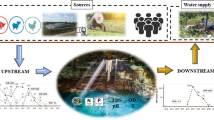Abstract
This paper deals with the importance of integrated hydrogeological, geological and geophysical applications in identifying suitable site for treatment, storage and disposal facility (TDSF) for industrial waste management. The pollution control authorities (Civic body) have a mandate to provide proper TSDF for the industrial zones. One such zone of 2800 acres, established by State Industries Promotion Corporation of Tamil Nadu (SIPCOT) at Perundurai in southern India, is selected to identify suitable TSDF site. The zone is envisaged to cater 22500 MTA (metric tones per annum) of industrial waste generated by 565 units. Hydrogeological and geological setup forms an important criterion in the process of environmental impact assessment (EIA) to establish proposed activity. Hydrogeological, geophysical and socio-economic/ecological studies were carried out to identify suitable TSDF site. Vertical electrical sounding (VES), multi-electrode resistivity imaging (MERI), ground penetrating radar (GPR) scanning, and infiltration tests were performed within the proposed TSDF site of 50 acres land. An inventory of 54 key wells includes depth to water level (varies from 9.7 to 15 m, below ground level) and water chemistry (pH, TDS, Ca2+, Mg2+, Na+, K+, Cl−, HCO −3 , SO 2−4 , NO −3 and F−) helped in identifying physical environment around (5 km radius) proposed TSDF site. Geophysical and hydrogeological investigations verified with drillings (at 5 locations) within the proposed TSDF site resulted, shallow hard rock at 4.5 m depth, the absence of groundwater, and low infiltration rate (4.3 cm/hour) of soil in the western side (45 acres) of proposed 50 acres land reveals suitability of TSDF site.
Similar content being viewed by others
References
Anchuela Pueyo, O., Casas-Sainz, Am., Soriano, Ma., Pocový’-Juan, A. (2009) Mapping subsurface karst features with GPR: results and limitations. Environ. Geol., v.58, pp.391–399.
Barker, R.D. (1992) A simple algorithm for electrical imaging of the subsurface. First Break., v.10, pp.53–62.
Bilgehan Nas., Tayfun Cay., Fatih Iscan and Ali Berktay (2010) Selection of MSW landfill site for Konya, Turkey using GIS and multi-criteria evaluation. Environ. Monit. Assess., v.160,Issue 1–4, page 491–500. DOI 10.1007/s10661-008-0713-8.
Cao Li-Wen, Cheng Yun-Huan, Zhang Jing, Zhou Xiao-Zhi and Lian Cui-Xia (2006) Application of grey situation decision making theory in site selection of a waste sanitary landfill. Jour. China Univ. Mining Tech., v.16, pp.393–398.
Chang, N., Parvathinathanb, G. and Breden, J.B. (2008) Combining GIS with fuzzy multicriteria decision making for landfill sitting in a fast-growing urban region. Jour. Environ. Managmt., v.87, pp.139–153. DOI:10.1016/j.jenvman.2007. 01.011.
Griffiths, D.H. and Barker, R.D. (1993) Two-dimensional resistivity imaging and modeling in areas of complex geology. Jour. Applied Geophys., v.29, pp.211–226.
Griffiths, D.H. and Turnbull, J. (1985) A multi-electrode array for resistivity surveying. First Break, v.3, pp.16–20.
Griffiths, D.H., Turnbull, J. and Olayinka, A.I. (1990) Two dimensional resistivity mapping with a computer-controlled array. First Break, v.8, pp.121–129.
Jorge, L., Porsania &, Walter, M., Filhob., Vagner, R., Elisa., Fisseha Shimelesa., Joaõ C. Douradob., Helyelson, P., Mourab. (2004) The use of GPR and VES in delineating a contamination plume in a landfill site: a case study in SE Brazil. Jour. Appld. Geophys., v.55(3–4), pp.199–209.
Montserrat Zamoranoa, Emilio Molerob, Alvaro Hurtadoa, Alejandro Grindlay and Angel Ramos (2008) Evaluation of a municipal landfill site in Southern Spain with GIS-aided methodology. Jour. Hazardous Materials, v.160, pp.473–481.
Owen, R.J., Gwavava, P. and Gwaze. (2005) Multi-electrode resistivity survey for groundwater exploration in the Harare greenstone belt, Zimbabwe. Hydrogeol. Jour., v.14, pp.244–252.
Smith, D.L. and Randazzo, A.F. (2003) Application of electrical resistivity measurements to an evaluation of a potential landfill site in a karstic terrain. Environ. Geol., v. 43, pp.743–751.
World Health Organization (WHO) (1984) Guideline of drinking quality (pp.333–335). Washington: World Health Organization.
Author information
Authors and Affiliations
Corresponding author
Rights and permissions
About this article
Cite this article
Sonkamble, S., Sethurama, S., Krishnakumar, K. et al. Role of geophysical and hydrogeological techniques in EIA studies to identify TSDF site for industrial waste management. J Geol Soc India 81, 472–480 (2013). https://doi.org/10.1007/s12594-013-0063-1
Received:
Revised:
Published:
Issue Date:
DOI: https://doi.org/10.1007/s12594-013-0063-1




